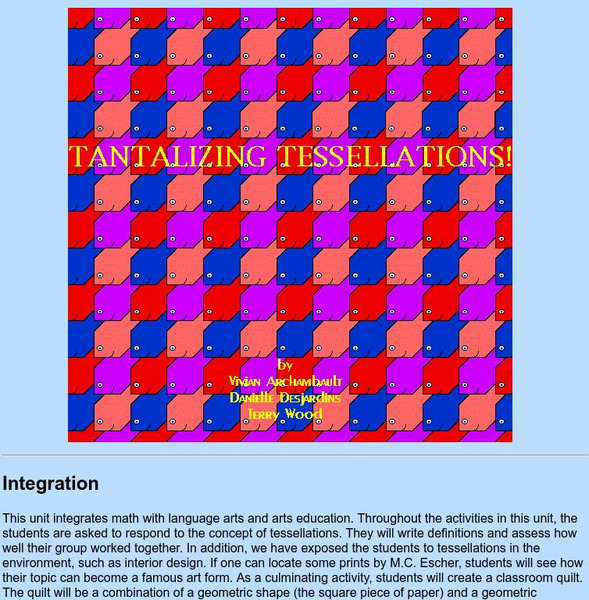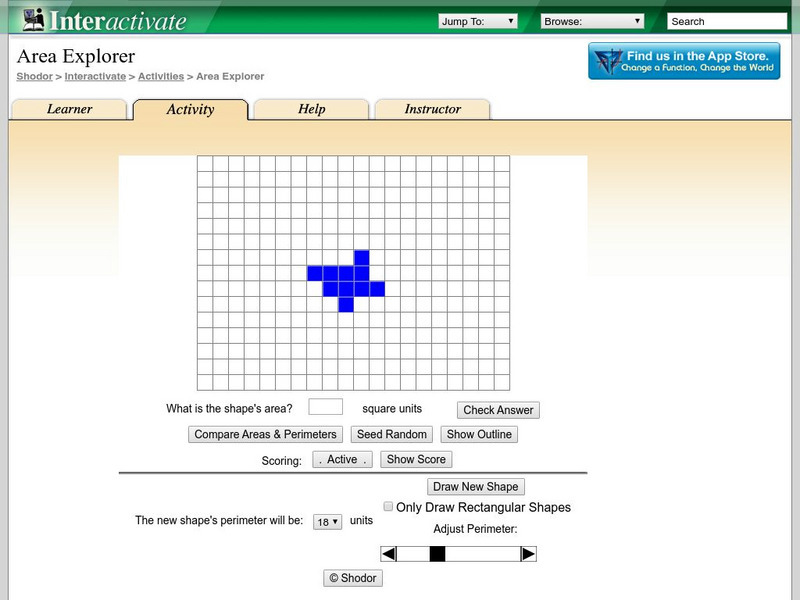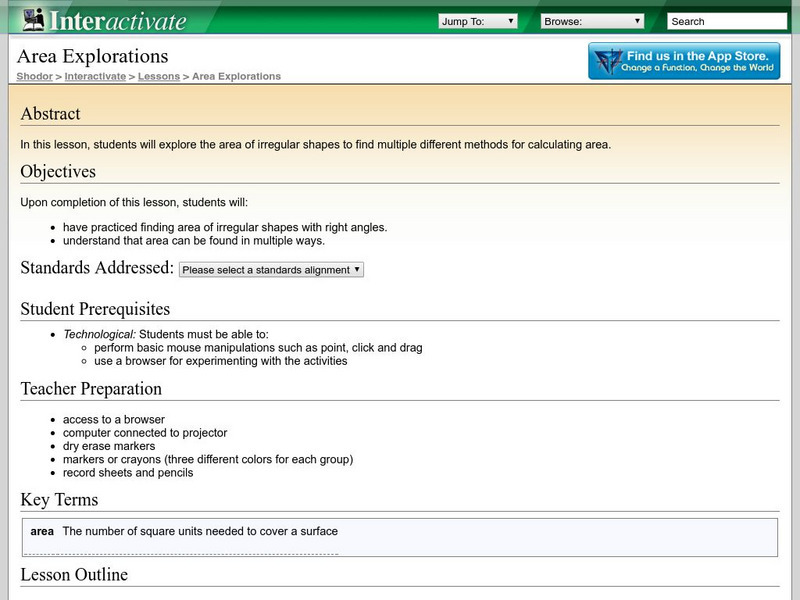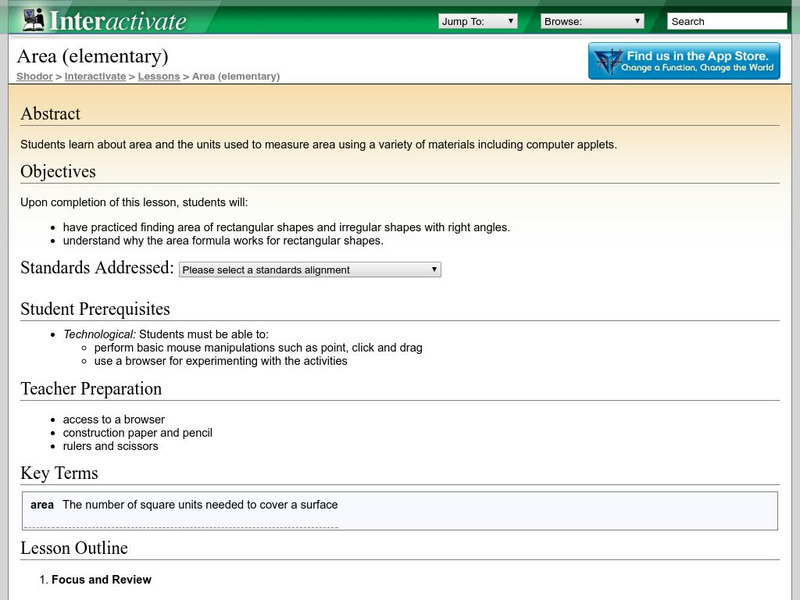Hi, what do you want to do?
Curriculum Corner
Area and Perimeter
Get third graders excited to work find area and perimeter of unit squares, rectangles, and irregular shapes. A 36-page packet comes with task cards, graphic organizers, practice worksheets, printables with squares, exit tickets, and word...
Common Core Sheets
Determining Rectilinear Area
Third graders find the area of rectilinear shapes by partitioning them into two non-overlapping rectangles and adding the areas of the non-overlapping parts together. It allows learners to recognize area as an additive.
Curated OER
The Square Counting Shortcut
An excellent lesson that encourages students to discover how complex figures can be broken into simpler shapes when measuring area. Working with block letters, learners are given the freedom to develop their own strategies for...
Under the Dome
Olympic Display
Design it with soda cases. After viewing a picture of a soda case display, pupils develop questions about the design using information from the teacher. Scholars use the information and their knowledge about area and multiplication to...
National Nanotechnology Infrastructure Network
Learning About Surface Area and Volume
Plan a dinner party. Using a book by Marilyn Burns as a context, pupils learn about the relationships between area and perimeter and surface area and volume. The hands-on activities have learners rearrange tables and cut up meatballs to...
PHET
Area Model Algebra
Expand the pupils knowledge of using area models to algebra. The interactive allows learners to use the same procedure of getting partial products when multiplying multi-digit numbers to multiplying polynomials. Scholars see how the...
PHET
Area Model Multiplication
Develop a solid understanding of multiplication. The interactive provides opportunities for learners to continue building a deep understanding of multiplication. Pupils use the application to find the product of two numbers and find...
PHET
Area Model Introduction
Provide two views of multiplication. The introduction to an area model application has two modes. One mode shows the area of simple multiplication up to 12 by 12. The second mode shows how area models can be partitioned leading to the...
PHET
Area Builder
All that matters is the tiles. Pupils use the interactive to investigate the relationship between area and perimeter using tiles. The interactive has an explore and a game mode to accommodate different steps in learning. The game mode...
Curated OER
Finding the Area of Polygons
Third graders are exposed to finding the area of polygons by decomposing figures and recomposing them into rectangles. This strategy allows children to expand on their prior knowledge of constructing shapes by rearranging parts into...
Doing Maths
Area of Various Shapes
Find the area of triangles, rectangles, and parallelograms using this metric worksheet.
National Security Agency
Awesome Area - Geometry and Measurement
Break out those math manipulatives, it's time to teach about area! Capturing the engagement of young mathematicians, this three-lesson series supports children with learning how to measure the area of squares, rectangles, and other...
Buffalo State
A Five Day Approach to Using Technology and Manipulatives to Explore Area and Perimeter
Young mathematicians build an understanding of area and perimeter with their own two hands in a series of interactive geometry lessons. Through the use of different math manipulatives, children investigate the properties of...
Government of Hong Kong
Areas and Volumes - 2D Shapes
Unfortunately for young mathematicians, the world isn't made entirely of parallelograms, triangles, and trapezoids. After first learning the area formulas for these common shapes, students apply this new knowledge to...
Arizona Department of Education
Area and Perimeter of Regular and Irregular Polygons
Extend young mathematicians' understanding of area with a geometry lesson on trapezoids. Building on their prior knowledge of rectangles and triangles, students learn how to calculate the area of trapezoids and other...
Centre for Innovation in Mamatics Teaching
Areas and Perimeters
Cover some serious area in your geometry curriculum with this collection of worksheets. After first introducing the concept of area using the tiling method, this resource continues on to teach learners how to use...
Math Worksheets Land
Recognize Area Word Problems - Matching Worksheet
Don't let the title fool you on this one; there aren't any word problems here. Scholars examine five rectangles that have been partitioned into rows and columns, determining the area based on these equal square units. Units aren't...
Math Worksheets Land
Recognize Area as Additive - Independent Practice Worksheet
Activate your geometer's minds with area calculations, some of which are tricky. First, they solve five word problems dealing only with rectangular shapes. The next five use irregular shapes with side measurements given. Scholars solve...
Math Worksheets Land
Recognize Area Word Problems - Independent Practice Worksheet
If a rectangle has three columns and four rows, how many squares does it have inside? Learners draw 10 rectangles based on specified rows and columns, counting the number of resulting squares. Keep in mind you may want to explain that...
University of Regina (Canada)
University of Regina: Math Central: Tantalizing Tessellations!
For this unit, students will be taught several techniques for creating tessellations and will respond to their learning in their Math journals.
Shodor Education Foundation
Shodor Interactivate: Lesson: Intro Fractals: Infinity/self Similarity/recursion
Explore fractions, ratios, area, and perimeter through guided practice lessons.
Shodor Education Foundation
Shodor Interactivate: Area (Elementary)
In this lesson students will practice finding the area of rectangular shapes and irregular shapes with right angles and understand why the area formula works for rectangular shapes. CCSS.Math.Content.3.MD.C.5.b A plane figure which can...
Shodor Education Foundation
Shodor Interactivate: Lesson: Area Explorations
In this lesson students will practice finding the area of irregular shapes with right angles and understand that there are different methods for calculating area.
Shodor Education Foundation
Shodor Interactivate: Lesson: Area (Elementary)
In this lesson students will practice finding the area rectangular shapes and irregular shapes with right angles and understand why the area formula works for rectangular shapes.




























